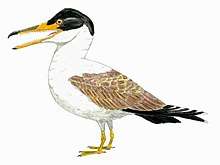Adasaurus
Adasaurus (/ˌɑːdəˈsɔːrəs/ AH-də-SAWR-əs; meaning "Ada's lizard") is a genus of dromaeosaurid theropod dinosaur that lived in Asia during the Late Cretaceous period. It was a small, ground-dwelling bipedal carnivore with a sickle-shaped claw on the second toe of each hind foot.
| Adasaurus | |
|---|---|
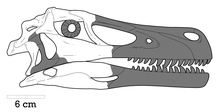 | |
| Reconstructed skull from the holotype IGM 100/20 | |
| Scientific classification | |
| Kingdom: | Animalia |
| Phylum: | Chordata |
| Clade: | Dinosauria |
| Clade: | Saurischia |
| Clade: | Theropoda |
| Family: | †Dromaeosauridae |
| Clade: | †Eudromaeosauria |
| Subfamily: | †Velociraptorinae |
| Genus: | Adasaurus Barsbold, 1983 |
| Type species | |
| †Adasaurus mongoliensis Barsbold, 1983 | |
Discovery and naming
The holotype of Adasaurus, IGM 100/20, and a second specimen, IGM 100/21, were unearthed from the Nemegt Formation at the locality of Bugin Tsav, in the Gobi Desert, Mongolia. The holotype consists of a partial skull and postcranial remains, while the other specimen is mostly represented by the hindlimbs and additional postcrania.[1] It was first reported on 1977 in a pelvic comparison with other theropods, and informally labelled as Adasaurus.[2] Later on, in 1983 it was shortly described and named by the Mongolian paleontologist Rinchen Barsbold along with other asiatic dinosaur genera. The generic name, Adasaurus, is taken from Ada, an evil spirit in the mythology of Mongolia, and the Greek word σαῦρος (sauros, meaning lizard). The specific name for the single species, mongoliensis, refers to the country of discovery: Mongolia.[1] Both specimens are housed in the collection of the Mongolian Geological Institute (IGM) in Ulaanbaatar, Mongolia.[1][3]
Currie and Varricchio in 2004 referred another two additional specimens, labelled as IGM 100/22 and IGM 100/23 that were recovered from the same locality of the holotype.[4] However, these specimens are actually known from the Shine Us Khuduk and Tel Ulan Chaltsai localities (respectively) at the Bayan Shireh Formation and thus, they are older than the remains of Adasaurus from the Nemegt Formation. Apparently, they represent a different and new taxa that differs from Adasaurus.[5][3]
Description

Adasaurus was a moderate-sized dromaeosaurid. During the description of Mahakala, by using body mass equations to estimate size and length in many paravians, Adasaurus was estimated at 2.39 m (7.8 ft) long with a weight of 36.4 kg (80 lb).[6] In 2012, Thomas R. Holtz estimated its length around 1.8 m (5.9 ft) and a weight around 9.1 to 22.7 kg (20.1 to 50.0 lb).[7] Nevertheless, Gregory S. Paul estimated its length at 2 m (6.6 ft) and gave a weight of 15 kg (33 lb) in 2016.[8] The holotypic remains are fragmentary, consisting of a skeleton with partial skull missing its anterior region, 9 cervical vertebrae, 3 partial dorsal vertebrae, and approximately 6 sacral vertebrae, the hindlimbs, a nearly complete right pelvic girdle compromising the illium, ischium and pubis. The second specimen, also briefly described in the original paper[1], consists of a right hindlimb, including a complete pes and other unspecified fragmented postcrania.[3] The femur of the holotype IGM 100/20 measures 27.3 cm (273 mm) and the fourth trochanter is developed in a ridge-like structure with a rugose texture. The femur itself is very similar to that of the indeterminate dromaeosaur DGBU-78, known from the Gugyedong Formation.[9][6]
In the original description, the only autapomorphy given to Adasaurus was the reduced second pedal ungual.[1] The authenticity of the reduced II pedal ungual has been disputed though, Senter 2010 claimed that the supposed ungual did not pertain to the specimen.[10] However, in the revised diagnosis conducted by Turner et al. 2012, Adasaurus can be recognised by the following traits: maxillary process of the jugal dorsoventrally expanded; the descending process of the lacrimal is strongly curved anteriorly; mandible with large surangular foramen; quadrate shaft with dorsally irregular triangular process along lateral border; only the anterior sacral vertebrae have pleurocoels; second pedal ungual reduced; the anterior margin of the preacetabular blade of ilium is short.[3]
Classification
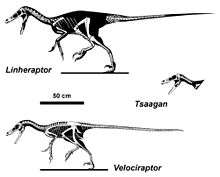
Adasaurus is a member of Dromaeosauridae, a group that is closely related to living birds. The anatomical features of Adasaurus seems to indicate a velociraptorine affinity. Traditionally, Adasaurus was assigned to the Dromaeosaurinae, which includes giant, heavily built animals such as Achillobator and Utahraptor[11][12] but several analyses have suggested that it belongs to the Velociraptorinae instead.[13][14][15]
When erected by Barsbold in 1983, Velociraptorinae was conceived as a group containing Velociraptor and closely related species that were characterized by their smaller size and long-narrow snouts. However, Barsbold did not included Adasaurus in the group.[1] It was not until 1998 that this group was defined as a clade by Paul Sereno. Sereno defined the group as all dromaeosaurids more closely related to Velociraptor than to Dromaeosaurus.[16] The traditional view of the Velociraptorinae commonly included Velociraptor, Tsaagan and Linheraptor, which are known from complete skulls, however, most analyses vary widely regarding which species are actually velociraptorines and which are dromaeosaurines. Turner et al. 2012 supported a traditional, monophyletic composition of Velociraptorinae.[3] However, some studies found a very different group of dromaeosaurids in Velociraptorinae, such as Longrich and Currie in 2009, which recovered Deinonychus outside of the Velociraptorine and Dromaeosaurinae. Saurornitholestes was recovered within the more basal group which they named Saurornitholestinae.[17]
Below is a cladogram based on the phylogenetic analysis conducted by Currie and Evans in 2019.[18]
| Eudromaeosauria |
| |||||||||||||||||||||||||||||||||||||||||||||||||||||||||||||||||||||||||||||||||
Paleoecology
The age of the Nemegt Formation has been estimated from the Late Campanian to Early-Middle Maastrichtian stages, about 70 million and 68 million years ago.[19] The environments that were present on the formation included stream and river channels, mudflats, and shallow lakes. Much of the sedimentation also indicates that a rich habitat existed, offering extensive vegetation in abundant amounts that could sustain most herbivorous dinosaurs. Most fluvial systems functioned as oases for oviraptorosaurs.[20][21][22][23] Other dinosaurs found in this formation include the ornithomimosaurs Anserimimus, Deinocheirus, Gallimimus and a fourth taxon that remains unnamed.[24]; diverse oviraptorosaurs such as Nemegtomaia, Elmisaurus and Gobiraptor[23][22]; the large troodontid Zanabazar[25]; the famous tyrannosaur Tarbosaurus and hadrosaur Saurolophus, among other dinosaurs.[26]
References
- Barsbold, R. (1983). "Хищные динозавры мела Монголии" [Carnivorous dinosaurs from the Cretaceous of Mongolia] (PDF). Transactions of the Joint Soviet-Mongolian Paleontological Expedition (in Russian). 19: 89. Translated paper
- Barsbold, R. (1977). "Эволюции Хищных Динозавров" [The Evolution of Predatory Dinosaurs]. Transactions of the Joint Soviet-Mongolian Paleontological Expedition (in Russian). 4: 48–56. Translated paper
- Turner, A. H.; Makovicky, P. J.; Norell, M. A. (2012). "A Review of Dromaeosaurid Systematics and Paravian Phylogeny". Bulletin of the American Museum of Natural History. 371 (371): 19–22. doi:10.1206/748.1. hdl:2246/6352.
- Currie, P. J.; Varricchio, D. J. (2004). "A new dromaeosaurid from the Horseshoe Canyon Formation (Upper Cretaceous) of Alberta, Canada". Feathered Dragons. Indiana University Press. p. 128. ISBN 0-253-34373-9. Book preview
- Kubota, K.; Barsbold, R. (2007). "New dromaeosaurid (Dinosauria Theropoda) from the Upper Cretaceous Bayanshiree Formation of Mongolia". Journal of Vertebrate Paleontology. 27 (suppl. to 3): 102A. doi:10.1080/02724634.2007.10010458.
- Turner, A. H.; Pol, D.; Clarke, J. A.; Erickson, G. M.; Norell, M. A. (2007). "A Basal Dromaeosaurid and Size Evolution Preceding Avian Flight". Science. 317 (5843): 1378−1381. Bibcode:2007Sci...317.1378T. doi:10.1126/science.1144066. PMID 17823350.
- Holtz, T. R.; Rey, L. V. (2007). Dinosaurs: The Most Complete, Up-to-Date Encyclopedia for Dinosaur Lovers of All Ages. Random House. Supplementary Information 2012 Weight Information
- Paul, G. S. (2016). The Princeton Field Guide to Dinosaurs (2nd ed.). Princeton, New Jersey: Princeton University Press. pp. 153−154. ISBN 9780691167664.
- Kim, H. M.; Gishlick, A. D.; Tsuihiji, T. (2005). "The first non-avian maniraptoran skeletal remains from the Lower Cretaceous of Korea". Cretaceous Research. 26 (2): 299−306. doi:10.1016/j.cretres.2005.01.001. OCLC 717973416.
- Senter, P. (2010). "Using creation science to demonstrate evolution: Application of a creationist method for visualizing gaps in the fossil record to a phylogenetic study of coelurosaurian dinosaurs". Journal of Evolutionary Biology. 23 (8): 1732–1743. doi:10.1111/j.1420-9101.2010.02039.x. PMID 20561133.
- Weishampel, D. B.; Dodson, P.; Osmolska, H. (2007). "Dromaeosauridae". The Dinosauria, Second Edition. University of California Press. pp. 196–209.
- Makovicky, P. J.; Apesteguía, S.; Agnolín, F. L. (2005). "The earliest dromaeosaurid theropod from South America". Nature. 437 (7061): 1007–1011. Bibcode:2005Natur.437.1007M. doi:10.1038/nature03996. PMID 16222297.
- Senter, P.; Kirkland, J. I.; Deblieux, D. D.; Madsen, S.; Toth, N. (2012). "New Dromaeosaurids (Dinosauria: Theropoda) from the Lower Cretaceous of Utah, and the Evolution of the Dromaeosaurid Tail". PLOS ONE. 7 (5): e36790. doi:10.1371/journal.pone.0036790. PMC 3352940. PMID 22615813.
- Cau, A.; Beyrand, V.; Voeten, D.; Fernandez, V.; Tafforeau, P.; Stein, K.; Barsbold, R.; Tsogtbaatar, K.; Currie, P.; Godrfroit, P. (2017). "Synchrotron scanning reveals amphibious ecomorphology in a new clade of bird-like dinosaurs". Nature. 552 (7685): 395–399. Bibcode:2017Natur.552..395C. doi:10.1038/nature24679. PMID 29211712.
- Hartman, S.; Mortimer, M.; Wahl, W. R.; Lomax, D. R.; Lippincott, J.; Lovelace, D. M. (2019). "A new paravian dinosaur from the Late Jurassic of North America supports a late acquisition of avian flight". PeerJ. 7: e7247. doi:10.7717/peerj.7247. PMC 6626525. PMID 31333906.
- Sereno, P. C. (1998). "A rationale for phylogenetic definitions, with application to the higher-level taxonomy of Dinosauria". Neues Jahrbuch für Geologie und Paläontologie - Abhandlungen. 210 (1): 41–83. doi:10.1127/njgpa/210/1998/41.
- Longrich, N. R.; Currie, P. J. (2009). "A microraptorine (Dinosauria–Dromaeosauridae) from the Late Cretaceous of North America". Proceedings of the National Academy of Sciences. 106 (13): 5002−5007. doi:10.1073/pnas.0811664106. PMC 2664043. PMID 19289829.
- Currie, P. J.; Evans, D. C. (2019). "Cranial Anatomy of New Specimens of Saurornitholestes langstoni (Dinosauria, Theropoda, Dromaeosauridae) from the Dinosaur Park Formation (Campanian) of Alberta". The Anatomical Record. 303 (4): 691–715. doi:10.1002/ar.24241. PMID 31497925.
- Owocki, K.; Kremer, B.; Cotte, M.; Bocherens, H. (2020). "Diet preferences and climate inferred from oxygen and carbon isotopes of tooth enamel of Tarbosaurus bataar (Nemegt Formation, Upper Cretaceous, Mongolia)". Palaeogeography, Palaeoclimatology, Palaeoecology. 537: 109190. doi:10.1016/j.palaeo.2019.05.012.
- Jerzykiewicz, T.; D.A. Russell (August 1991). "Late Mesozoic stratigraphy and vertebrates of the Gobi Basin". Cretaceous Research. 12 (4): 345–446. doi:10.1016/0195-6671(91)90015-5.
- Averianov, A.; Sues, H. (2012). "Correlation of Late Cretaceous continental vertebrate assemblages in Middle and Central Asia" (PDF). Journal of Stratigraphy. 36 (2): 462−485. hdl:10088/19377. ISSN 0253-4959.
- Funston, G. F.; Mendonca, S. E.; Currie, P. J.; Barsbold, R.; Barsbold, R. (2018). "Oviraptorosaur anatomy, diversity and ecology in the Nemegt Basin". Palaeogeography, Palaeoclimatology, Palaeoecology. 494: 101–120. doi:10.1016/j.palaeo.2017.10.023.
- Lee, S.; Lee, Y. N.; Chinsamy, A.; Lü, J.; Barsbold, R.; Tsogtbaatar, K. (2019). "A new baby oviraptorid dinosaur (Dinosauria: Theropoda) from the Upper Cretaceous Nemegt Formation of Mongolia". PLOS ONE. 14 (2): e0210867. doi:10.1371/journal.pone.0210867. PMC 6364893. PMID 30726228.
- Chinzorig, T.; Kobayashi, Y.; Tsogtbaatar, K.; Currie, P. J.; Takasaki, R.; Tanaka, T.; Iijima, M.; Barsbold, R. (2018). "Ornithomimosaurs from the Nemegt Formation of Mongolia: manus morphological variation and diversity". Palaeogeography, Palaeoclimatology, Palaeoecology. 494: 91–100. doi:10.1016/j.palaeo.2017.10.031.
- Norell, M. A.; Makovicky, P. J.; Bever, G. S.; Balanoff, A. M.; Clark, J. M.; Barsbold, R.; Rowe, T. (2009). "A Review of the Mongolian Cretaceous Dinosaur Saurornithoides (Troodontidae: Theropoda)". American Museum Novitates. 3654: 1–63. doi:10.1206/648.1. hdl:2246/5973.
- Fanti, F.; Bell, P. R.; Currie, P. J.; Tsogtbataar, K. (2020). "The Nemegt Basin — One of the best field laboratories for interpreting Late Cretaceous terrestrial ecosystems". Palaeogeography, Palaeoclimatology, Palaeoecology. 494: 1–4. doi:10.1016/j.palaeo.2017.07.014.

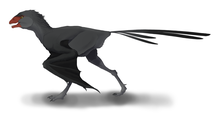

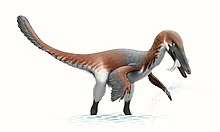
.png)





.png)

